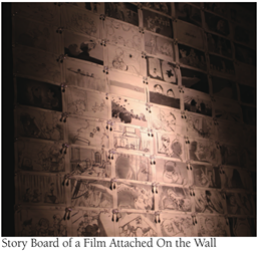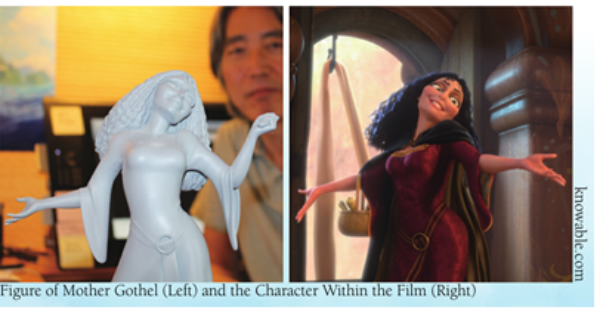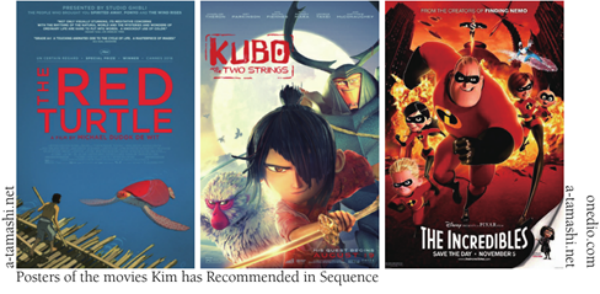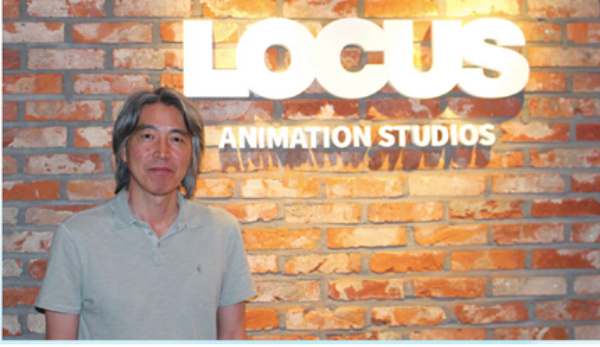As the summer vacation arrives as soon as the stressful finals end, many Kingos might be planning to visit some exhibitions during the upcoming summer. In particular, the Pixar 30 Years of Animation Exhibition is being held at the Dongdaemun Design Plaza (DDP), which is located near the Humanities and Social Sciences campus, and is drawing a massive number of people. Considering the hits of animations such as Frozen and Moana, it is hardly deniable that animation has become a massive part of culture in Korea. The characters in the successful film gain enormous love from all around the world; however, the producers of the images are rarely appreciated by the public. Therefore, the Sungkyun Times (SKT) met animator Kim Sang-Jin, former top animator and character design supervisor for Disney, and heard some of the stories from behind the scenes of the animation world.
Animator, Kim Sang Jin
1. An animator is a job that might be unfamiliar to the public in Korea. As an animator who has worked in the field for a long time, how would you define the term ‘animator’?
It is difficult to define the term animator in one word, but to put it simply, animators are people who create visual effects by turning inanimate objects into moving images though drawing, computers, or dolls. In other words, animators make lifeless things move by blowing life into them, as if the Latin words anima or animates, the origin of the word ‘animation’ which means living thing or to make something alive or move. That, however, does not really mean that the lives of animators are special every day, but it requires h i g h c r e a t i v i t y a n d technical skills to express something with one’s hands.
2. It seems that the childhood of successful people usually has many connections with their current career. Was your childhood mainly influenced by animation as well? Furthermore, it was interesting to find that you majored in economics in college. Did you have any interest on economics? Wasn’t your major a barrier on getting a job highly related to art?
I never thought to become an animator when I was young, but I did like to draw from an early age. Before I became an animator, I did not even know that this kind of a job existed in Korea. I simply kept drawing because I liked it, and fortunately I find myself engaging in the animation industry now. The reason that I studied economics was that I could not enroll into a College of Fine Arts due to red-green color blindness. To some extent, I got desperate and decided to major in economics without consideration. Majoring in economics, however, did not get in the way of me becoming an animator because at that time, most of the animators drew images using only pencil and paper. Since they did not have to color the images or require specific coloring techniques, non-art majoring people like me could also get a job without any restrictions as long as our drawing skills were good.
3. Giving up your goal to enter the College of Fine Arts due to a physical defect must have been very distressing, but you finally ended up becoming an animator. Did you always have the belief that you would become an animator later on in life?
Rather than a belief or resolution, I just wanted to do what I liked to do. If I were more patient and determined, I might have done things for the sake of money even though I did not like it, but I was not that kind of a person. To be frank, I did not have any goals such as becoming an animator or entering Disney, but kept drawing which I liked to do. It really did improve my drawing skills naturally, and I got to know the animation industry by chance as my brother handed me a newspaper about animation.
If I were not prepared, however, I would have missed the chance even if it passed right by me. I think I was able to catch the opportunity because I was prepared enough.
4. You also worked as a character design supervisor during your later years in Disney. Can you explain the exact difference between a character designer and animator? Didn’t the red-green color blindness hinder your work as a character designer?
To give an example for general motion pictures, a character designer is the same as the casting director, who searches for the right actors for each character after reading a script. In other words, character designers literally design the characters described in the story according to the style of the movie, opinion of the director, and their own ideas. Animators, on the other hand, make those created characters act. Since the working styles of every character designer differ, the red-green color blindness was not an obstacle for me as a character designer as well. If I had to use colors, I simply assigned those tasks to people who were good at colors.
5. Wasn’t it hard to work as the first top Korean animator at Disney due to the absence of a pioneer before you? What was your happiest memory while working in Disney?
Since there are so many predecessors who have been designing the characters, I never thought about the absence of pioneers. Actually, I do not enjoy being called ‘the first top Korean animator’ as well because there is no meaning in becoming the first or the last. What is important is to learn from what the foregoers have accomplished so far and teach those to the successors. There is no one certain happiest memory, but I still remember the overwhelming moment when I first started to work at Disney. Encountering the animators who I admired, respected, and learned through the books in the hallways, working with them, and even having lunch with them were dream-like experiences. Of course I got used to it as time went by, but all it indeed was a blissful moment for me when I just started to work in a huge, world-leading animation studio.
Animator and Animation
6. Would you please introduce the overall process of animation production and which part takes the most time and labor?
Making an animation is a highly complicated and time-consuming process. Unlike the general motion pictures where actors and the background or landscape already exist to some extent, people need to make something out of nothing in animation. Even a small leaf of a tree in the background should be designed. Also each of the 24 frames which constitute one second of the film needs to be created by animators, so it takes a very long time to complete the movements of the characters. The overall process can be divided into the planning step where the script, synopsis, character designs, and story boards are made and the production step where the actual i m a g e s a r e c r e a t e d .Although every step is a long process, the most time and labor consuming aspect is the planning stage. Since it is the most important part of the production, almost all of the studios spend most of their time and capital here.

7. It seems that most of the Disney characters share the same physical characteristics such as big and round eyes. Is there any guideline within the studio?
Many people say that some Disney styles exist, but I think it is half correct and half not. So to speak, it is normal for the styles of the drawing to become similar as animators work together. The big and round eye expressions of Disney are related to technical reasons.The bigger the eyes of the characters become, the easier and faster it is for the audience to catch the emotion o f t h e c h a r a c t e r s .Moreover, since the animation genre was initiated from and completed in the Walt Disney Studios, most of the major animation films are under the influence of Disney. People who are teaching animation are also from Disney. Even the founders of Pixar and DreamWorks, international major animation studios, have worked in Disney once. Therefore, people generally learn Disney styles consciously and unconsciously from a young age.
8. Among the characters you have designed, which one do you feel the strongest attachment to?
Mother Gothel in Tangled is my favorite one among those I have designed. It took a really long time and a lot of effort to find the most matching design for the character, so she is the most special to me.

9. It is said that currently most films are computer animated. So are the hand-drawn animations no longer being made? As an animator who started to work before the introduction of computer animations, which type do you prefer?
Still, two-dimensional (2D) movies are being made, but there are only a few. Major studios no longer make 2D movies, while small and medium studios keep working on them. Even though some people speculated that the life of 2D movies would be over since the first computer animation Toy Story was made, I think that both 2D and computer-graphic (CG) animations could coexist.
Personally, I prefer the traditional way; with stop motion movies using dolls such as with Coraline. Although they might seem similar to computer animations because CG is also used, the texture is different and I like those differences.
10. As an animator, which animation would you like to recommend and what is your must-see animation?
I would like to recommend The Red Turtle which is a 2D movie totally out of the mainstream. It is an animation for adults but it is totally fine for children to watch as well. I would also like to recommend Kubo and the Two Strings, which is a fabulously artistic and amazing stop motion film. It would be really nice for people to go and watch it, but it is too bad that few people enjoy watching minor animations. Personally, I really like The Incredibles from Pixar because not only is it didactic but also entertaining.
In addition, it is a family movie as well as a super hero movie, showing all the emotions of human beings such as betrayal, love, and jealousy like a full package of presents.

Animation in Korea
11. As a former top animator in Disney, the dream land of the animation industry, what do you think is the obstacle that hinders the development of Korean animation films?
Even if a computer is used during the production, animation is eventually made by artists who are humans. Compared to the United States (US), however, the domestic environment and conditions provided to the artists are insufficient and should be improved a lot. Still many studios in Korea seem to be thinking of how to make a film faster and cheaper. I understand the background of the poor conditions such as low investment in the industry, but in the long term, government, studios, and colleges need to cooperate to make a system that generates and supports good artists. Furthermore, low social recognition of animators ought to be changed to resolve poor development of animation.
12. Accordingly, what do you think animation education in Korea should aim for?
I do not know very much about animation education in Korea, but recently I heard that more than 100 universities in Korea have made an animation major. If that is true, I think it might be a big problem.
Even in the US, which has the biggest animation industry, there are only a few colleges that have an animation major, and those schools have great faculty who are working in the field and a historical curriculum which has been generating skillful animators. In Korea, however, who are the staff of those numerous animation majors and where did they all come from? Even if the students learn animation, is the industry itself in Korea big enough to embrace and utilize all those students? I do not really think so. This is quite a heavy and serious problem which is hard to find a key to the solution for, but experts in the education field must think about it sincerely.
13. Is there any particular reason you left Disney where you worked for more than 20 years and instead settled in Korea? What are your future plans?
To be honest, I do not have any plans or goals. Locus, a company I am currently working for, has been working on an animation project Red Shoes and the 7 Dwarfs very slowly since 2010 and started to progress in the past two years. Personally, I had been feeling a little bit stagnant in Disney as I had been there for more than 20 years, and coincidentally I had a chance to help the initial character design and become related to the project of Locus. As the production genuinely began, I thought maybe my career in the animation field might be helpful for the company that just gave a challenge to produce an animation. Since it is the first time for both the company and the staff to make an animation, it is very meaningful to help them and become a member of making an animation in Korea. Therefore, my current plan is to successfully complete this project, creating a condition where we can try for the next film consequently, and to make the world surprised by showing that an animation like this can be made in Korea as well.
14. Please introduce Red Shoes and the 7 Dwarfs.
As you can infer from the title, it is a story which has reinterpreted Snow White. Although the motive of the film came from Snow White, there are many differences. It is a story about the process of the seven dwarfs, who are seven princes put under a curse and are trying to lift their curses and meet Princess Snow during their journey. The film will be released in 2018.

15. Lastly, do you have anything to say for the students who are dreaming of becoming animators?
For those who are considering becoming animators, I really want to say that it is sincerely an entertaining job. If it was not fun, I would not have been working for this long. There are so many kinds of animations, not just the major animations but also short animation films and more. If you are wishing to chase the money, I would like to suggest other careers, but if you really want to live a fun life, I truly recommend you to keep doing what you are dreaming of now.

Since it is uncommon for ordinary people to be able to peek through to the backstage world of animation, the time SKT had with animator Kim Sang Jin was very meaningful. Behind the gorgeous animations, there are the efforts of animators giving life to imagination. It would be nice for Kingos to think of the busy and interesting work behind the screen whenever they are watching animation films from now on.
